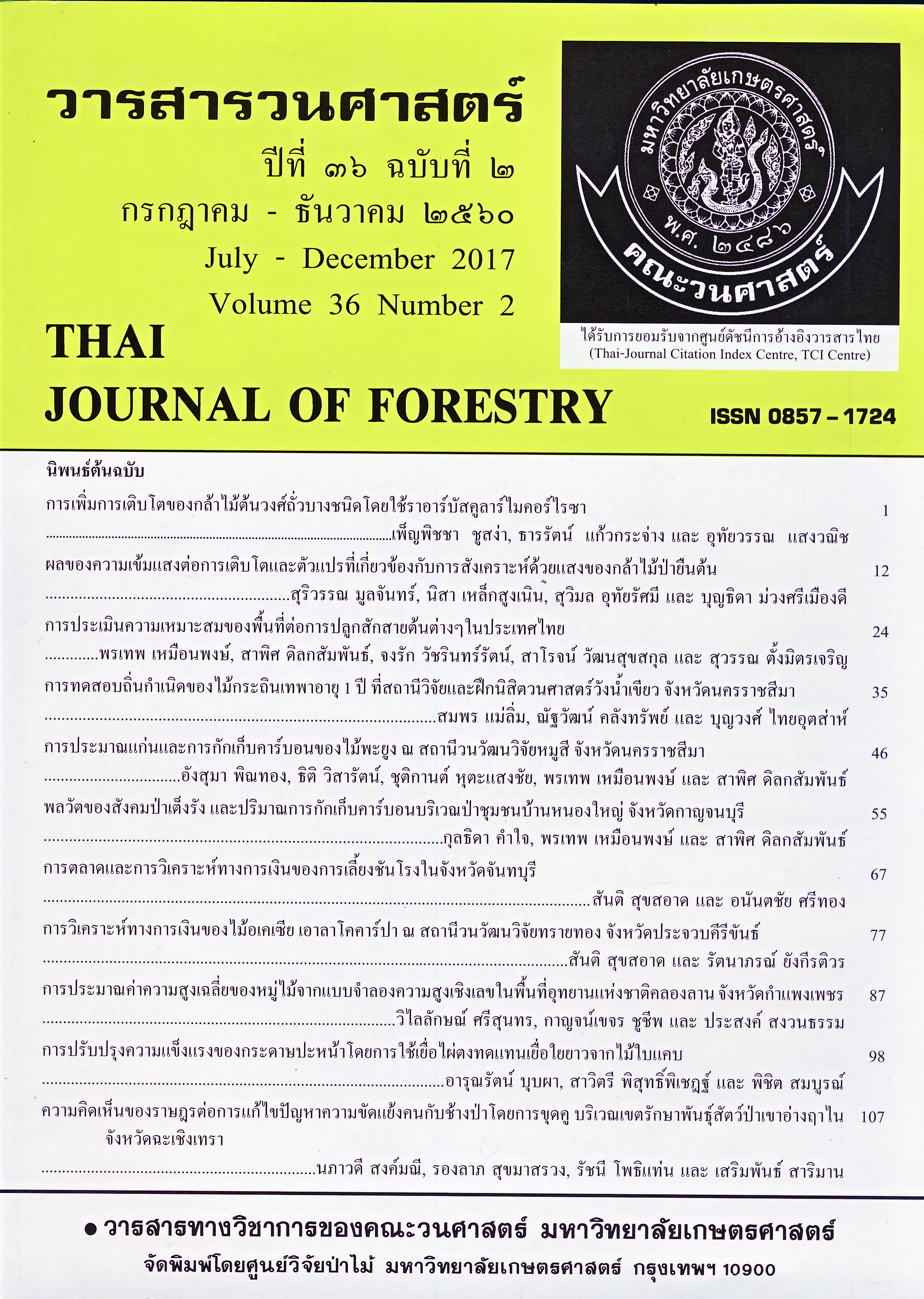การประมาณค่าความสูงเฉลี่ยของหมู่ไม้จากแบบจำลองความสูงเชิงเลข ในพื้นที่อุทยานแห่งชาติคลองลาน จังหวัดกำแพงเพชร
Main Article Content
บทคัดย่อ
การวิจัยครั้งนี้มีวัตถุประสงค์เพื่อประเมินแบบจำลองความสูงเชิงเลข (digital elevation model; DEM) ใน รูปแบบ Digital Terrain Model (DTM) และ Digital Surface Model (DSM) ที่ได้รับอิทธิพลจากเรือนยอดของหมู่ไม้ และเพื่อทดสอบความเป็นไปได้ในการใช้ค่าความต่างระดับความสูงระหว่าง DTM และ DSM ประมาณค่าความสูงเฉลี่ยของหมู่ไม้ในพื้นที่อุทยานแห่งชาติคลองลาน จังหวัดกำแพงเพชร โดยทดสอบกับแบบจำลองความสูงระดับโลก (Global DEMs) ได้แก่ ASTER GDEM และ SRTM รวมทั้งแบบจำลองความสูงที่ใช้ในประเทศ ได้แก่ ข้อมูล DEM ที่จัดทำขึ้นโดยกรมแผนที่ทหาร (RTSD DEM) และข้อมูล DEM ที่จัดทำขึ้นโดยกรมพัฒนาที่ดิน (LDD DEM) ทำการหาค่าความต่างระดับความสูงของแบบจำลองความสูงในแต่ละคู่ แล้วหาค่าดัชนีพืชพรรณ ได้แก่ NDVI, SAVI, และ RVI ที่หาจากภาพถ่ายจากดาวเทียม Landsat 8 วิเคราะห์ความสัมพันธ์ระหว่างค่าความต่างระดับความสูงของแบบจำลองความสูงกับดัชนีพืชพรรณแต่ละชนิด จากนั้นนำค่าดัชนีพืชพรรณที่มีค่าสัมประสิทธ์ิสหสัมพันธ์สูงสุดมาจำแนกความแตกต่างของชั้นหมู่ไม้ โดยในแต่ละชั้นของหมู่ไม้จะสุ่มวางแปลงตัวอย่างแบบวงกลมขนาด 17.84 เมตร จำนวน 40 แปลง เพื่อเก็บข้อมูลความสูงของต้นไม้ เพื่อนำมาหาความสัมพันธ์กับค่าความต่างระดับความสูง ของ DTM และ DSM ด้วยการวิเคราะห์การถดถอย (regression analysis) นำสมการความสัมพันธ์ที่ได้ มาใช้ในการประมาณความสูงเฉลี่ยของหมู่ไม้ในพื้นที่อุทยานแห่งชาติคลองลาน
ผลการวิจัยพบว่า ค่าความต่างระดับความสูงของข้อมูล DEM กรมแผนที่ทหาร (RTSD DEM) กับ DEM ของกรมพัฒนาที่ดิน (LDD DEM) มีความสัมพันธ์กับค่าดัชนีพืชพรรณสูงกว่าแบบจำลองความสูงที่ใช้ในระดับโลก (Global DEMs) โดยมีค่าสัมประสิทธิ์สหสัมพันธ์ คือ 0.57, 0.50 และ 0.59 สำหรับดัชนีพืชพรรณ NDVI, SAVI, และ RVI ตามลำดับ สมการความสัมพันธ์ที่ได้มา คือ c = 2.2826 + 0.81
spc (โดย
c คือ ความสูงเฉลี่ยของหมู่ไม้จากการประมาณด้วยสมการ,
spc คือ ค่าความต่างระดับความสูงของแบบจำลองความสูง) มีค่าสัมประสิทธ์ิตัวกำหนด เท่ากับ 0.69 จากสมการ ที่ได้สามารถสร้างแผนที่ความสูงของหมู่ไม้ของทั้งพื้นที่ศึกษาได้ โดยความสูงเฉลี่ยของหมู่ไม้ของทั้งพื้นที่มีค่า ประมาณ 16.86 เมตร มีค่ารากที่สองของความคลาดเคลื่อนกำลังสองเฉลี่ย (root mean square error; RMSE) เท่ากับ 2.37 ดัชนีความสอดคล้อง (d) เท่ากับ 0.48 และค่าความผิดพลาดสัมบูรณ์เฉลี่ย (mean absolute error; MAE) เท่ากับ -2.05
Downloads
Article Details
ข้าพเจ้าและผู้เขียนร่วม (ถ้ามี) ขอรับรองว่า ต้นฉบับที่เสนอมานี้ยังไม่เคยได้รับการตีพิมพ์และไม่ได้อยู่ในระหว่างกระบวนการพิจารณาตีพิมพ์ลงในวารสารหรือสิ่งตีพิมพ์อื่นใด ข้าพเจ้าและผู้เขียนร่วม (ถ้ามี) ยอมรับหลักเกณฑ์และเงื่อนไขการพิจารณาต้นฉบับ ทั้งยินยอมให้กองบรรณาธิการมีสิทธิ์พิจารณาและตรวจแก้ต้นฉบับได้ตามที่เห็นสมควร พร้อมนี้ขอมอบลิขสิทธิ์ผลงานที่ได้รับการตีพิมพ์ให้แก่วารสารวนศาสตร์ คณะวนศาสตร์ มหาวิทยาลัยเกษตรศาสตร์ กรณีมีการฟ้องร้องเรื่องการละเมิดลิขสิทธิ์เกี่ยวกับภาพ กราฟ ข้อความส่วนใดส่วนหนึ่ง หรือ ข้อคิดเห็นที่ปรากฏในผลงาน ให้เป็นความรับผิดชอบของข้าพเจ้าและผู้เขียนร่วม (ถ้ามี) แต่เพียงฝ่ายเดียว และหากข้าพเจ้าและผู้เขียนร่วม (ถ้ามี) ประสงค์ถอนบทความในระหว่างกระบวนการพิจารณาของทางวารสาร ข้าพเจ้าและผู้เขียนร่วม (ถ้ามี) ยินดีรับผิดชอบค่าใช้จ่ายทั้งหมดที่เกิดขึ้นในกระบวนการพิจารณาบทความนั้น”
เอกสารอ้างอิง
สุเพชร จิรขจรกุล. 2555. เรียนรู้ระบบสารสนเทศภูมิศาสตร์ด้วยโปรแกรม ArcGIS 10.1 for Desktop. พิมพ์ครั้งที่ 1. ภาควิชาเทคโนโลยีชนบท คณะวิทยาศาสตร์และเทคโนโลยี มหาวิทยาลัยธรรมศาสตร์ ศูนย์รังสิต, ปทุมธานี.
สำนักงานนโยบายและแผนทรัพยากรธรรมชาติและสิ่งแวดล้อม. 2558. โครงการเตรียมรับมือและป้องกันผลกระทบจากการเปลี่ยนแปลงสภาพภูมิอากาศที่อาจมีต่อระบบนิเวศและสิ่งแวดล้อมแหล่งธรรมชาติอันควรอนุรักษ์ ประเภทน้ำตก. กระทรวงทรัพยากรธรรมชาติและสิ่งแวดล้อม, กรุงเทพฯ.
Geo-Informatics and Space Technology Development Agency (Public Organization) - GISTDA. 2012. The Meaning of the Height Information Terrain. Available source: https://sites.google.com/site/ lidardemservice/khwam-hmay-khxng-khxmul-khwam-sungphumiprathes-thi-hi-brikar, October 8, 2015.
Huete, A. 1988. A Soil-adjusted vegetation Index (SAVI). Remote Sensing of Environment 25: 295-309.
Jordan, C.F. 1969. Derivation of leaf area index from quality measurements of light on the forest floor. Ecology 50: 663-666.
Krause, P., D.P. Boyle and F. Base. 2005. Comparison of Different Efficiency Criteria for Hydrological Model Assessment. Advances in Geosciences 5: 89-97.
Rouse, J.W., R.H. Haas, J.A. Schell and D.W. Deering. 1973. Monitoring vegetation systems in the Great Plains with ERTS. NASA SP-351I 309-317.
United States Geological Survey. 2015. Landsat Missions Timeline. Available source: http://landsat.usgs.gov/about_mission_history.php, October 8, 2015.
Willmott, C.J. 1982. Some comments on the evaluation of model performance. Bulletin of the American Meteorological Society 63 (11): 1309-1369.
Walker, W.S., L.E. Pierce, J.M. Kellndorfer, M.C. Dobson, C.T. Hunsaker and J.A. Fites. 2004. A comparison of forest canopy height estimates derived from SRTM and TOPSAR in the Sierra Nevada of California. Geoscience and Remote Sensing Symposium 4: 2336- 2339


